BUSINESS
Your Message Here
Podcasts Sit at the Intersection of Technology and a Familiar Format. Can They Help Get Your Message Out?
By Chris Shelton
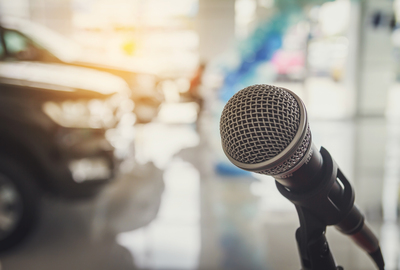
An interview format where hosts pitch ads feels a touch anachronistic in this digital-everything age. Podcasts seem more like the kind of medium our grandparents’ generation would’ve invented, had the internet spontaneously appeared in their youth. You just know Milton Berle would’ve slayed.
But it’s a format suited uncannily well to a world stretched thin by obligation and distraction. Largely audio, podcasts are a multitasker’s dream come true; they’re something you can do while you’re doing, well…other things. You can cook dinner, mow the lawn, work out, drive or do any number of things that don’t consume full mental bandwidth—all while listening to a podcast.
That helps explain the medium’s staggering growth. According to Podcast Index, 4,058,591 podcasts titles exist as of July 2022, a figure that increased by 579,519 since November 2021. For context, only 547,969 podcast titles existed in November 2016. And content creators enjoy a booming listener base. Data aggregator Statista estimates that more than 100 million Americans will consume podcasts by 2024, a figure up by 15 million since 2020.
But are podcasts the next big way to get your message out? Are they something you should consider as part of your business’ marketing strategy? We pitched the question to a few colleagues operating in the podcast space.
“Four or five months ago I would have said I had no idea,” says Josh Henning, director of operations and business development at chassis manufacturer Roadster Shop and cohost of the company’s “Oil & Whiskey” podcast. “But after hearing the stories that I’ve heard from shops that we talked about or had on as guests, of how it’s moved their needle, it’s a different story. Which is humbling because I would’ve never even thought that could come from something like this.”
Matt Avery, executive producer and cohost of Mecum Auction’s “On the Move,” relates. “Podcasts are a valuable tool in getting the word out for a variety of reasons,” he says. “It’s a very solid and established platform to communicate to your audience about whatever message you’re trying to get out, whether that be the release of a new product or a service or appearance at a show.”
As they and others explain, podcasting offers businesses the ability to build
awareness and stronger relationships with clients. What follows is a loose list of things that make the podcast stand out in a sea of media options.
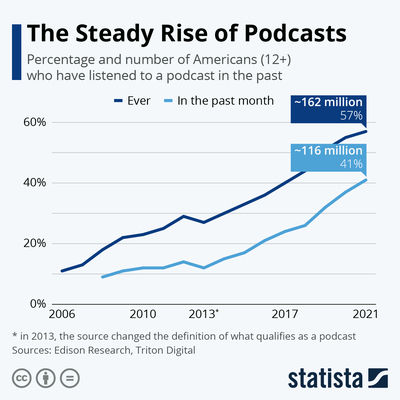
According to data analyst Statista, roughly 162 million Americans 12 and older (more than half of the total population) consumed podcasts by 2021. Of those, 116 million consumed one in the month prior to the survey. And it’s not a kids’ medium, either; according to estimates from Edison Research’s long-term Infinite Dial survey, 21% of people 55 and older consume podcasts monthly. Even major media organizations are embracing podcasting to deliver long-form content.
Connecting With Listeners in Your Market
Perhaps you’ve heard the axiom, People do business with people they know, like, and trust. We usually exercise it by asking a friend for contacts in a business. “[Listeners] have a perceived relationship with hosts and guests,” says car builder and “Car Guy Confessionals” co-host Steve Strope. It’s a matter of “I like the way this guy thinks,
I like his persona. I think I would like to do business with him,” he observes.
Podcasts also offer a somewhat special connection with their audiences. As they do in any other format, podcast hosts tend to specialize in a subject or at least a limited range of similarly themed subjects. The hosts of “Oil & Whiskey,” for example, tend to focus on things related to Roadster Shop’s core business: bespoke chassis for older modified American cars and trucks. So, they represent a direct channel of communication to a very specific demographic of engaged consumers. Followers of “Oil & Whiskey,” for example, are probably more inclined to spend their money on a product or service geared towards older modified American cars and trucks. That’s the obvious part.
…And Finding New Ones in Others
But that focus has soft edges. The “Oil & Whiskey” hosts also talk a lot about, well…whiskey. And knives. And firearms. And whatever else overlaps the Venn diagram of those topics. “So, we’re getting followers from those niche audiences [who] are learning about cars,” Henning says. “And now they’re like, ‘oh crap! I want, like, a four-wheel-drive truck!’ We have guys that are into car stuff. They’re like, ‘man, these knives are cool. I’m buying one!’” He says they’re getting feedback from brands discussed on their show. “‘Hey, these guys just called up and ordered these guns or these knives or this whiskey, you know, and they’re getting into it from your podcast.’”
More than wide, podcasting also tends to run deeper than many other media formats. “It lets you communicate at a different level than those other channels, for example, video or written,” Avery notes. “If you’re dealing with a print piece or a news article, often you’re dealing with a word count. Typically, with a podcast, you can expand on ideas or chat about different things in great detail.”
“It gives us a way to talk about what you have going on right now,” Henning adds. “With social media, everything’s live. It’s like breaking news. But with podcasts you can go a little bit deeper and explain something, and sometimes explaining something in an entertaining way [is] different than, you know, ‘here’s a cool picture of it. Call us.’”
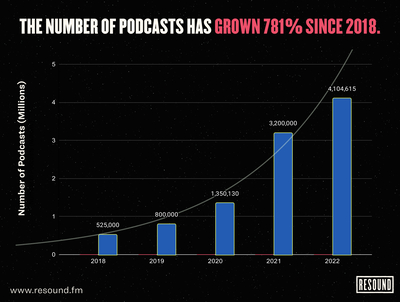
Podcast listeners enjoy a staggering number of podcast titles: 4.1 million as of 2022 according to Resound.fm. That’s up a full million from 2021 and up more than 300% since the start of the pandemic. And the range is diversifying—a great number of the titles in the automotive niche appeared during the past two years.
Developing Communication Skills
While the audio format has incredible power in the communication world, its narrower bandwidth and reduced production costs (compared to, say, video) give it a more informal feel. That informality offers latitude to develop communication skills. “If you’re developing your sales or editorial team, it can be beneficial to get them out of their comfort zone, i.e., hiding behind a press release,” Avery says. “When you’re having to respond to questions in real time, it sharpens your team to address things that maybe wouldn’t have come up in a closed-door brainstorming session.
“It’s also good for all of us to learn to be succinct and to communicate our ideas. It forces you to go over the main points about the message you’re trying to communicate. That’s why podcasts should be one of the major avenues that teams look at when it comes to getting the word out about something new.”
Podcasts offer an opportunity to spotlight commonly overlooked team members. “I’ve encountered that many times over the years,” Avery says. “It allows you to connect with people that necessarily aren’t on the front lines but are key to subject-matter experts and can truly provide valuable insight. I’m thinking of conversations we’ve had with OEMs, where we’ve been able to connect with engineers, developers and more that can provide another in-depth viewpoint to that first line of marketing personnel. These are great individuals to connect with, as in the case of an auto manufacturer, these are the actual people directly connected to the vehicles that we’re test driving.”
“It gives you as a team member or a leader in your organization the opportunity to bring to light the people who have their sleeves rolled up that are working on the parts that you’re selling, or the technology you’re developing or whatever. While not necessarily the driving force for a decision to push into the podcast arena, it can be a peripheral benefit.”
Appearing in podcasts, especially with key players on your organization’s team, also fosters a sense of expertise. “That, to me, has value,” Strope says. “If you’re on somebody’s website or podcast or interview, that’s strengthening your brand; it’s showing that you have value because they’re asking you to be a guest.”
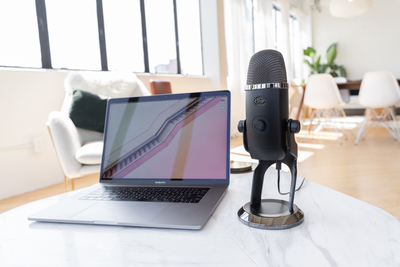
The market responded to creators’ demands for high-quality microphones with a diverse array of affordable options. Logitech offers a range in its Blue series, including the Yeti X condenser microphone. It features four modes: cardioid for single-person presentations, omni for conference calls, bidirectional for one-on-one interviews, and stereo for detailed recordings. USB microphones like these pair just as well with smartphones and tablets as they do with computers. And they retail for not much more than $100.
Targeting Your Audience
The threshold to entry may be lower and its bandwidth may be narrower, but podcasting still requires a strong level of homework, even for guests. “As with any successful marketing campaign, a lot of it comes down to the preparation,” Avery says. And it begins by targeting your audience by choosing the right host.
“When a skilled team is looking out over the launch and deployment of any kind of news content, target the podcast[s] that you want to be on. Look over who’s out there. A simple online search will provide options, or connecting with someone on the SEMA team can be a great step. Anyone who is part of and active with SEMA probably already has resources available in terms of showing who the personalities are in that space.”
From there, he says it’s no different than appealing to other forms of media. Often a press release is enough to open a door.
“Craft a targeted appeal to the host or the producer. And just as when you’re sending out a press release, be prepared to provide additional assets,” Avery maintains. “That can be a big draw. A lot of the successful podcasts are not restricted to audio formats alone. A lot of them have a video presence—a show page, for example.
“Because a lot of these shows are hosted on what we would think of as traditional blog posts, they can embed additional media assets. So don’t overlook that. That can really help to put your show above and beyond, and further connect you with your audience.
“The nice thing about podcasts is that they tend to be on the smaller scale of production, as opposed to some of the growing TV or YouTube channels where you have multiple levels of production teams and even various producers. It can be difficult to approach and pitch to these on-air personalities. However, connecting with a podcast show or on-air host can be more attainable.”
For an idea of how the process sometimes looks from the other side, Josh Henning explained how he and his co-hosts Phil and Jeremy Gerber choose guests. “If it’s somebody that we want to talk to and we think it’s going to be an interesting conversation, I don’t care what industry they are from, what product they have, or where they’re coming from,” he says. “If they’ve got 50 followers or 5 million followers, it doesn’t matter. If we think it’s going be an interesting and fun conversation that we would enjoy, we’ll do it.”
“Just do your homework,” Avery instructs. “Then be clear about what you’re trying to communicate about your desire to come on their show. Discuss what would be relevant to their listeners.”
Then develop a rapport in terms of what the host or hosts want to cover. “Present how a potential segment spotlighting your brand or news fits into the overall show,” Avery said. “If it’s a new technology or service or product, that’s clear. But on the other hand, it’s always nice to present or pitch other potential topics of conversation to the host. That can help them with show development, and you never know how that might open the door to more. Maybe you start with your bit of news but by offering some other topics that are relevant, you fit into a larger theme.”
Honing Your Message
Avery has a few pointers to prepare for the podcast recording. “I typically put together a couple of talking points just to get into that habit of looking at what I want to cover when I’m on-air.” He says he usually covers only about a third of what he intends, but the headroom is priceless. “That way, if you do have more time, you’re always thankful that you’ve got something more to discuss. It also shows respect to your listeners by providing meaningful content as opposed to rambling. Be prepared and be professional.”
At the same time, expect curveballs. “I’ve been on many podcasts where the hosts or producers say in advance, ‘…we want to talk about this, this and this.’ And leading up to the show recording I’ve been preparing for those exact talking points,” Avery says. “Then, suddenly, on air the host wants to take a curve, take a sharp turn and asks something off the wall. That’s not always the case but that goes back to being prepared and learning to deal with the unexpected.”
Stripping away the visual side of the presentation may simplify the process. But it also intensifies the perception of what remains, specifically the audio part. “I’ve held many interviews with high-level team members at well-known companies and organizations and it sounds tinny because of the lack of decent equipment,” he says.
“If you’re looking to move into podcasting—even just to be featured on one—take steps for your production to be successful. You don’t need a full-blown studio but get a good-quality microphone, even a USB microphone and find a quiet place in the office to record. It really doesn’t take that much from a dollar standpoint to come across clear and have a nice warm tone. In addition to the actual message of what you’re communicating, that’ll help make the conversation more engaging and enjoyable to listeners.”
The Big Payback
The give-and-take model of podcasting has one last appeal and a kind of obligation. “Podcasts give guests material that they can use and showcase on their own marketing channels,” Avery says. More than make the most of your company’s message, promoting the podcast you appear on benefits your host, making the experience fully reciprocal. Remember, podcasters are businesses too.
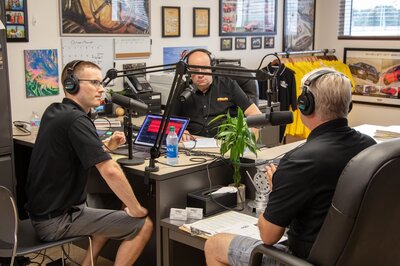
Podcasting imposes a relatively low bar, at least production-wise. For example, Matt Avery and John Kraman host Mecum’s “On the Move” podcast from pretty much anywhere they can plug in. The pandemic also inspired entirely remote formats, where guests and hosts connect online. It’s not uncommon to participate in podcasts hosted in entirely different states if not countries, but you’d never know it judging by the finished product. Photo courtesy: Andrew MacKey
Just Do It
Emerging technology makes a darling of every new medium that it inspires, and at the pace that technology develops it seems almost impossible to keep up. But podcasts, with their low barriers and increasingly larger audiences, have great potential. When asked if businesses should make podcast appearances a part of their marketing strategy, every expert we talked to responded positively.
“It’s the adage about marketing: 10% of it works—you just don’t know which 10% is working,” Josh Henning says. “It’s the same thing with going to the shows, doing SEMA, doing print ads and doing our social media. With everything that’s going on—YouTube, social media and our podcast stuff—it’d be great to be able to know which one that’s giving us ROI. But it’s all brand building out there.”
“I would say there’s built-in potential [and] inherent value,” Steve Strope adds. “The potential’s there, one set of eyes or ears could make a great difference and you will never reach them if you don’t at least go out there and give it a try. You know, what’s it gonna hurt?” he asks. “What could possibly go wrong?”






